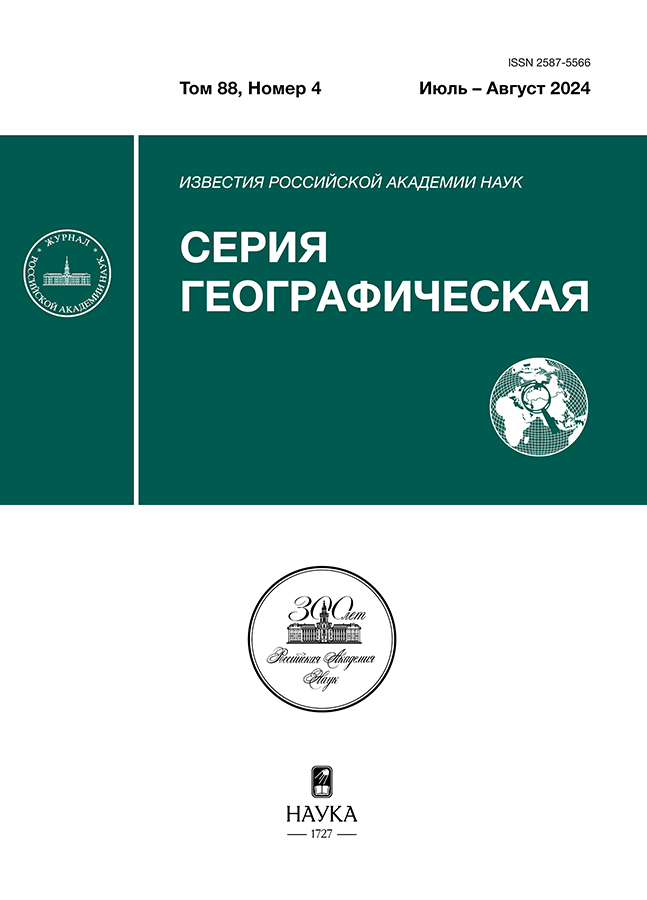Geography of Unbranched Channels and Conditions for Their Formation
- Autores: Chalov R.S.1, Chalova E.R.1, Golubtsov G.B.1
-
Afiliações:
- Lomonosov Moscow State University
- Edição: Volume 88, Nº 4 (2024)
- Páginas: 496-507
- Seção: NATURAL PROCESSES AND DYNAMICS OF GEOSYSTEMS
- URL: https://journals.eco-vector.com/2587-5566/article/view/660824
- DOI: https://doi.org/10.31857/S2587556624040032
- EDN: https://elibrary.ru/RQGCRZ
- ID: 660824
Citar
Texto integral
Resumo
A geographical analysis is given of the conditions for the development and distribution of rectilinear unbranched channels, forming morphologically homogeneous areas, “inserts” between bends and islands in meandering and braided rivers, as well as channel branches (island branches), floodplain channel branches, and bifurcated channels. It is shown that morphologically homogeneous areas with this type of channel are relatively rare on rivers, which is associated with the instability of rectilinear flow movement. The conditions under which the formation of straight channels is possible are identified: the location of wide floodplain channels along the bedrock banks, on rivers with an incised channel, etc. The developed small-scale map shows the zoning of the territory of Russia according to the distribution of straight, unbranched channels and their occurrence on small and medium-sized rivers with other types of channels. On large and large rivers, sections of straight channels are identified, as well as manifestations of straightness in the form of “inserts” between adjacent bends and branches of different types, in branches of branches of different morphodynamic types and structural levels. The reasons and conditions of transformation of straight channels into sinuous and branched (transforming) channels or their non-transformability in different regions of the country are considered.
Texto integral
Sobre autores
R. Chalov
Lomonosov Moscow State University
Autor responsável pela correspondência
Email: rschalov@mail.ru
Faculty of Geography
Rússia, MoscowE. Chalova
Lomonosov Moscow State University
Email: ekar28@yandex.ru
Faculty of Geography
Rússia, MoscowG. Golubtsov
Lomonosov Moscow State University
Email: georgy1995golubcov@yandex.ru
Faculty of Geography
Rússia, MoscowBibliografia
- Chalov R.S. Geograficheskie issledovaniya ruslovykh protsessov [Geographic Studies of Channel Processes]. Moscow: Izd-vo Mosk. Gos. Univ., 1979. 232 p.
- Chalov R.S. Channel processes of the USSR rivers and their small-scale mapping. In Trudy 5 Vsesoyuz. Gidrol. S’’yezda. T. 10. Ruslovye protsessy i nanosy [Proc. of the 5th All-Union. Hydrol. Congress. Vol. 10. Channel Processes and Sedimentation]. Leningrad, 1988, pp. 259‒266. (In Russ.).
- Chalov R.S. Ruslovedenie: Teoriya, geografiya, praktika. T. 1. Ruslovye protsessy: faktory, mekhanizmy, formy proyavleniya i usloviya formirovaniya rechnykh rusel [Theory, Geography, Practice. Vol. 1. Channel Processes: Factors, Mechanisms, Forms and Conditions of Channel Formation]. Moscow: LKI Publ., 2008. 608 p.
- Chalov R.S. Ruslovedenie: teoriya, geografiya, praktika. T. 2. Morfodinamika rechnykh rusel [Riverbed Science: Theory, Geography, Practice. Vol. 2: Morphodynamics of River Channels]. Moscow: KRASAND Publ., 2011. 960 p.
- Chalov R.S., Alabyan A.M., Ivanov V.V., Lodina R.V. Panin A.V. Morfodynamika rusel ravninnykh rek [Riverbed Morphodynamics of Plain Rivers]. Moscow: GEOS Publ., 1998. 288 p.
- Chalov R.S., Berkovich K.M., Kirik O.M., Svatkova T.G. Application of the cartographic method in the study of channel processes. Geogr. Prir. Resur. , 1986, no. 3, pp. 10‒16. (In Russ.).
- Chalov R.S., Chalov S.R. Discrete properties of channel processes and their reflection in the morphodynamics of river channels. Vodn. Resur. , 2023, vol. 87, no. 2, pp. 234‒249. (In Russ.).
- Chalov R.S., Chalova E.R. Geography of branched rivers on the territory of Russia. Izv. RGO , 2019, vol. 151, no. 6, pp. 28‒34. (In Russ.).
- Chalov R.S., Chalova E.R. Geographical patterns of river channel meandering in Russia. Geogr. Nat. Resour. , 2023, vol. 44, pp. 198–207. https://doi.org/10.1134/S1875372823030034
- Chalov R.S., Shuguan L., Alekseevskii N.I. Stok nanosov i ruslovye protsessy na bol’shikh rekakh Rossii i Kitaya [Sediment Runoff and Channel Processes in Large Rivers in Russia and China]. Moscow: Izd-vo Mosk. Gos. Univ., 2000. 216 p.
- Chenkuan L. Riverbed classification. Nankin Univ. Publ., 1963, no. 1, pp. i–i. (In Chinese).
- Grishanin K.V. Teoriya ruslovogo protsessa [Chаnnel Process Theory]. Moscow: Transport Publ., 1972. 216 p.
- Grishanin K.V., Zamyshlyaev V.I. The emergence of river meandering as a problem of hydrodynamic instability. Tr. GGI , 1985, vol. 301, pp. 5‒12. (In Russ.).
- Ivanov V.V. Formation conditions, hydrological-morphometric dependencies and deformations of relatively straight, unbranched channels. Extended Abstract of Cand. Sci. (Geogr.) Dissertation . Moscow: Moscow State Univ., 1989. 23 p.
- Karasev I.F. Ruslovye protsessy pri perebroske stoka [Channel Processes During Runoff Diversion]. Leningrad: Gidrometeoizdat Publ., 1975. 288 p.
- Kondrat’ev N.E., Popov I.V., Snishchenko B.F. Osnovy gidromorfologicheskoi teorii ruslovogo protsessa [The Basics of Hydromorphological Theory of Channel Processes]. Leningrad: Gidrometeoizdat Publ., 1982. 272 p.
- Makkaveev N.I. Stok i ruslovye protsessy [Runoff and Channel Processes]. Moscow: Izd-vo Mosk. Gos. Univ., 1971. 116 p.
- Rosgen D.L. A classification of natural rivers. Catena , 1994, vol. 22, pp. 169‒199.
- Rossinskii K.I., Kuz’min I.A. Some issues of the applied theory of river channel formation. In Problemy regulirovaniya rechnogo stoka [Problems of River Flow Regulation]. Moscow-Leningrad: Izd-vo AN SSSR, 1947, pp. 88‒129. (In Russ.).
- Rossinskii K.I., Kuz’min I.A. Patterns of formation of river channels. In Ruslovye protsessy [Channel Processes]. Moscow: Izd-vo AN SSSR, 1958, pp. 5‒14. (In Russ.).
- Rozovskii I.L. Dvizhenie vody na povorote otkrytogo rusla [Movement of Water at a Bend in an Open Channel]. Kiev: Izd-vo AN SSSR, 1957. 188 p.
- Ruslovoi rezhim rek severnoi Evrazii [Channel Regime of North Eurasia Rivers]. Moscow: Izd-vo Mosk. Gos. Univ., 1994. 336 p.
- Ruslovye protsessy na rekakh SSSR, 1 : 4000000 [Channel Processes on the USSR Rivers, 1 : 4000000]. Moscow: GUGK SSSR, 1990. 4 p.
- Shen H.W., Schumm S.A., Doehring D.O. Stability of stream channel patterns. Transp. Res. Rec. , 1979, no. 736, pp. 22‒38.
- Shen Yuichan, Gun Goyuan. River Geomorphology . Pekin: Nauka Publ. 1986.
- The fluvial system . Schumm S.A., Ed. New York: Wiley, 1977. 338 p.
- Tsyan Nin, Chzhan Zhen, Chzhou Tszyde. Channel Processes. Pekin: Nauka Publ., 1987. 584 p.
Arquivos suplementares












